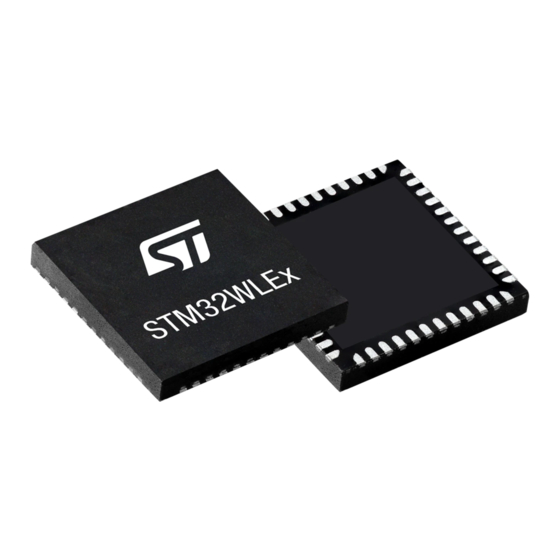
STMicroelectronics STM32WLEx Wireless Manuals
Manuals and User Guides for STMicroelectronics STM32WLEx Wireless. We have 1 STMicroelectronics STM32WLEx Wireless manual available for free PDF download: Reference Manual
STMicroelectronics STM32WLEx Reference Manual (1306 pages)
Advanced Arm-based 32-bit MCUs with sub-GHz Radio Solution
Brand: STMicroelectronics
|
Category: Microcontrollers
|
Size: 26 MB
Table of Contents
-
-
Glossary56
-
SRAM Erase61
-
Introduction62
-
Empty Check70
-
Transmitter111
-
Receiver112
-
Rf-Pll113
-
Lora Modem115
-
Lora Framing117
-
FSK Modem119
-
Generic Framing120
-
MSK Modem120
-
BPSK Modem122
-
BPSK Framing123
-
Calibration Mode126
-
Sleep Mode126
-
Startup Mode126
-
Standby Mode127
-
(Subghz_Gsyncr4)167
-
(Subghz_Gsyncr5)167
-
(Subghz_Gsyncr6)167
-
(Subghz_Gsyncr7)167
-
(Subghz_Paocpr)175
-
Power Supplies182
-
Low-Power Modes193
-
Run Mode199
-
Table 39. Lprun200
-
Sleep Mode201
-
Stop 0 Mode203
-
Stop 1 Mode205
-
Stop 2 Mode206
-
Standby Mode208
-
Shutdown Mode210
-
PWR Registers212
-
PWR Register Map228
-
Power Reset230
-
Reset230
-
System Reset230
-
Clocks232
-
PKA SRAM Reset232
-
HSI16 Clock237
-
-
Is Not Used729
-
Preloaded)797
-
(Tim16/17)829
-
(M Bits = 00)1045
-
(M Bits = 01)1046
-
(M Bits = 00)1047
-
FIFO Disabled)1063
-
FIFO Disabled)1127
-
Figure 354. I1185
-
Table 259. ROM Table1251
Advertisement
Advertisement
Related Products
- STMicroelectronics STM32WL5 Series
- STMicroelectronics STM32WL55 Series
- STMicroelectronics STM32WL54 Series
- STMicroelectronics STM32L151R8
- STMicroelectronics STM32L152VB
- STMicroelectronics STM32L152V8
- STMicroelectronics STM32L151VCH6
- STMicroelectronics STM32L152VCT6
- STMicroelectronics STM32L152VCH6
- STMicroelectronics STM32L151RE
